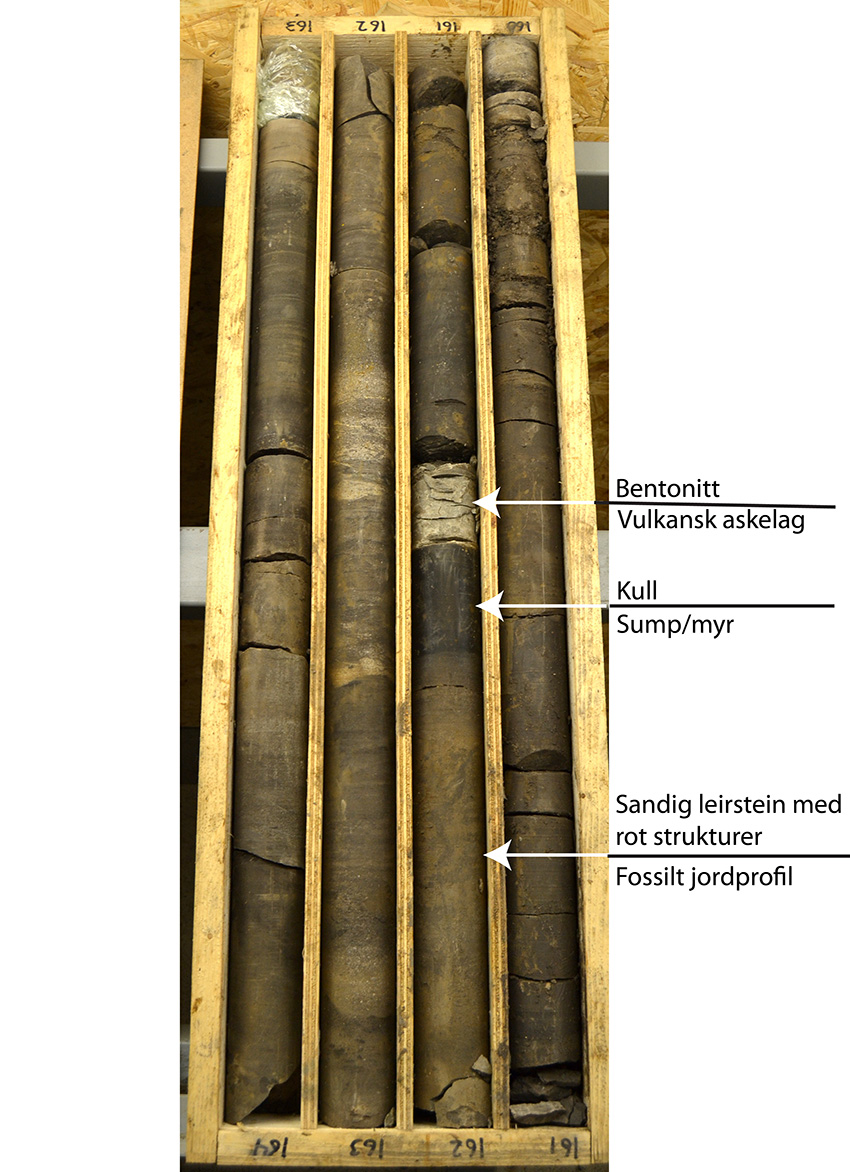Back when the dinosaurs were ash-stranded
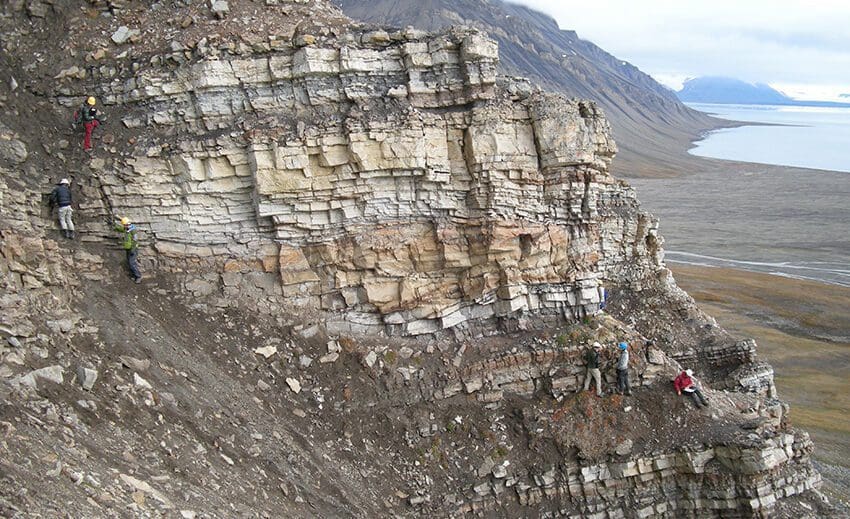
UNIS students log a steep sloping exposure with sandstones and shales from the Helvetiafjellet Formation on Ullaberget in Van Keulenfjorden, just above Annahamna. Here we also find dinosaur tracks. Photo Snorre Olaussen/UNIS.
Top image: UNIS students log a steep sloping exposure with sandstones and shales from the Helvetiafjellet Formation on Ullaberget in Van Keulenfjorden, just above Annahamna. Here we also find dinosaur tracks. Photo: Snorre Olaussen/UNIS.
If you are in the centre of Longyearbyen, you may not be aware that dinosaurs roamed here in a lush subtropical forest 125 million years ago and that “we” were about where the city of Bodø, Norway is today. This was a period of huge volcanic eruptions and a subtropical climate.
30 April 2021
Text: Snorre Olaussen, UNIS; Sten Andreas Grundvåg, The Arctic University of Norway, Tromsø; Jørn Hurum, Natural History Museum, University of Oslo and Kim Senger, UNIS.
In Longyearbyen we walk, cycle and drive on roads of loose material that are several thousand years old. Longyearbyen and Barentsburg exist due to coal formed by peat from swamps that covered the landscape about 60 million years ago. Back then, the climate in Svalbard was like today’s forests in Southern Europe or California.
But we are going further back in the history of the planet. Just below Longyearbyen are rocks from the first part of the Cretaceous period, from 100 to 145 million years ago. These are rocks that originate from clay and sand laid down in a shallow stormy sea, river plains and deltas, surrounded by lush forests and swamps.
Sandstones and shales from the Cretaceous can be found along the cliffs by the road to the airport, the coastal cliffs towards Bjørndalen and on the slopes up to the mining elements in Longyeardalen, Adventdalen and Hiorthfjellet. If you are looking for fossil tree trunks, mussels and ammonites, there are opportunities in all these areas.
But all these rocks are above, and are thus a little younger, than the rocks we find dinosaur tracks in. The footprints occur in a geological unit with alternating layers of sandstone and shale with a few coal layers from the Helvetiafjellet Formation named after the Helvetiafjellet where theses rocks are outcropping. These sedimentary rocks were once deposited on vast river plains. 125 million years ago, when this sandstone was just loose sand, Svalbard had a rich, varied and heat-loving flora with a bustling wildlife. The wildlife of that time stood in stark contrast to today’s Arctic fauna, with flocks of herbivorous dinosaurs and the occasional carnivore wandering around unaware of their catastrophic fate in the form of an upcoming violent volcanic eruptions.
Although we knew a lot about Cretaceous rocks on Svalbard right from the first studies by the Swedish naturalist Alfred Nathorst’s exploration of King Karl’s Land in 1898 and onwards, there have been several loose ends.
In 2012, UNIS and the University of Stavanger (UiS) proposed a research project for the industry based on a “gruk” from the Danish mathematician Piet Hein: Knowing what you do not know is a kind of omniscience. With the support of nearly 20 industrial companies and in collaboration with the mainland universities and universities in Moscow, Austin, Texas and Copenhagen, we received funding for a three-year project: “Lower Cretaceous basin studies in the Arctic” (abbreviated to LoCrA), where UNIS’s role in the project was first and foremost to map and describe the Cretaceous layer series on Svalbard, while UiS focused on the underground on both the Norwegian and Russian sides of the Barents Sea.
Temperate to subtropical forest and mangroves in Adventdalen?
What did it look like on Svalbard and the surrounding areas in the part of the Cretaceous period when the Helvetia mountain formation was formed, and the dinosaurs ruled the globe?
As a time picture for approx. 125 million years ago, just take a look at Adventdalen, Adventelva and Adventfjorden and multiply the size of the river plain by a few 1000 times and turn Adventelva’s coastline to the south. Then we lay on mangrove forests on the coastal strip and when you go up the valley you will see dense forests on both sides of a river not unlike Adventelva midsummer with all its gravel and sand banks. But the valley was considerably wider, and the sides of the valley were hardly more than a maximum of a few hundred meters high.
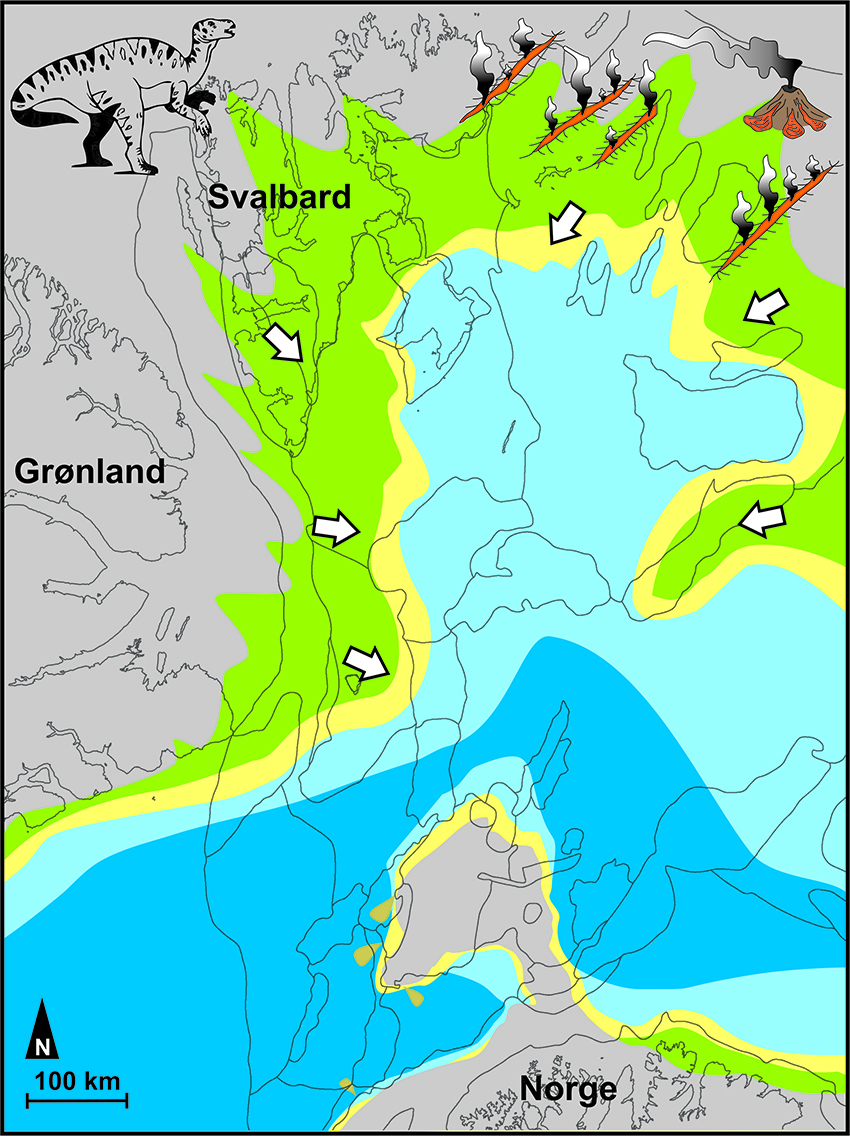
In addition to plant fossils that show a heat-loving flora, we find remains of marine lizards, fish, octopuses, shells, sea urchins and not least the footprints of dinosaurs that have so far been found in six places on Spitsbergen. A single bone probably belonging to a prehistoric bird has also been found on Schønrockfjellet on the east coast of Spitsbergen. But of course, we still hope for proper findings of dinosaur bones.
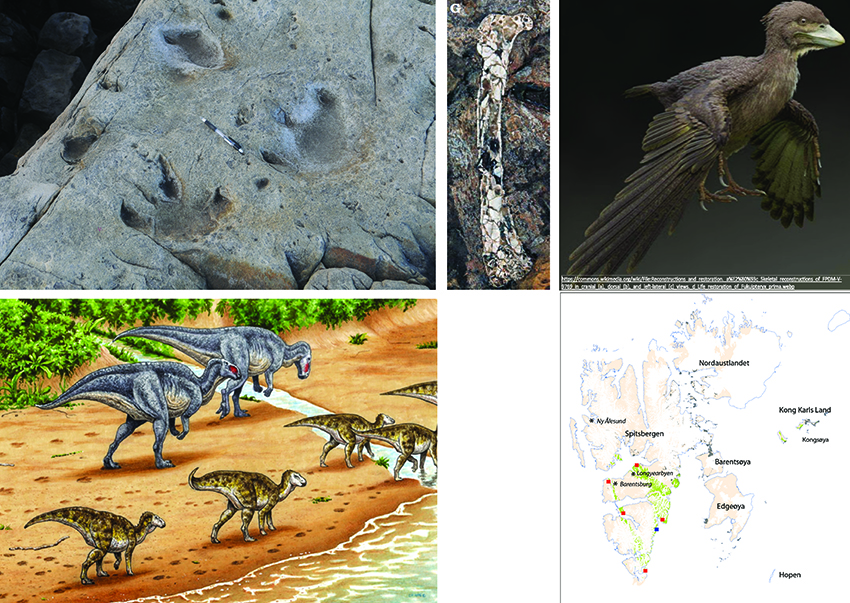
Remains of a huge Arctic volcanic province
As exciting as fossil remains of flora and fauna are traces of a simultaneous gigantic volcanism in Svalbard. Not only in Svalbard, it covered large parts of the Arctic. Everywhere on the archipelago we see remnants of this violent chapter in Svalbard’s history.

This is also one of the most conspicuous rocks on Svalbard, you see them immediately when you come out of Adventfjorden. These dark rocks that cut into the surrounding soft shales in the mountainsides above Vindodden and Botneheianosa or stand as steep coastal cliffs at Diabasodden and Hatten or form the well-known amphitheatre at Hyperittfossen.
The rock is called dolerite and forms passages that mostly follow the slope of the surrounding layers, but in some cases, they climb upwards and cut across the row of layers as vertical passages. Dolerite is very resistant to weather and wind, and at Rotundafjellet by Kapp Thordsen on the north side of Isfjorden they form protective caps for underlying shales that are less resistant to erosion. Some may have found dangerous reefs near Gåsøyane; the dolerite is also known as an effective propeller killer.
These rocks appear best in March-April as black horizontal lines in the landscape. Try to notice these the next time you drive into Sassendalen in the direction of Fullmardalen.
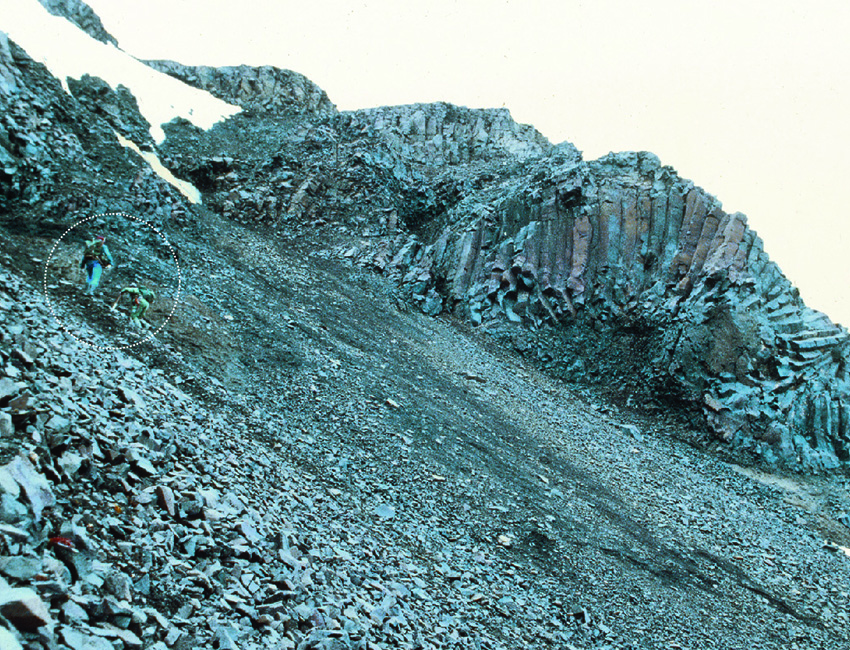
Dolerite is formed from lava that penetrated into the surrounding rocks that were about 1 to 2 kilometers deeper into the earth’s crust than now. When the lava then solidified, they became dolerite, or basalt or diabase if you will; Dear children have many names, but in practice it is the same. During and just after cooling, the solidified lava shrank and burst into a distinctive column pattern such as what we see at Diabasodden and Hatten today. On Kongsøya in Kong Karl’s Land we find lava that flowed over river plains and sprayed ash from volcanic cones and open cracks in the earth’s crust. Volcanic ash layers have been found in the Helvetiafjellet Formation during the drilling of several of the CO2 wells in Adventdalen. In the event of major volcanic eruptions, dense ash clouds are transported far away by the air currents and are eventually deposited on the ground as an all-covering veil of ash. These ash layers break down rapidly into clay minerals and then form a deposit called bentonite*. In the bentonites one can also find small crystals of the mineral zircon which are formed during the actual volcanic eruption. We can date these crystals and thus they can give us an age of formation and a relatively accurate estimate of when the eruption took place.
The CO2 boreholes in Adventdalen
The bentonite that was encountered during the drilling in Adventdalen is about 20 cm thick and is located at a depth of about 157 meters. A group at the Department of Geosciences at the University of Oslo (Corfu and co-workers) dated the zircons to 123.3 million years +/- 200,000 years which is remarkably accurate.
We geologists are overjoyed when we get such good data. Since the bentonite was encountered at about the same level in almost all the CO2 wells, we gradually understood that they belonged to the same single event. There is good reason to believe that some dinosaurs gained speed when this cloud came, but some probably perished. The size of the eruption must have been something completely different than the small fart from the volcanic eruption in 2010 from Eyjafjallajökulls (Isl: Eldgosið í Eyjafjallajökull) where we were all ash trapped. We do not find 20 cm of compact bentonite after it.
Volcanism and climate change
It was not only the Arctic that had great volcanic activity during this period, also in southern latitudes larger volcanic provinces were formed. As mentioned, Svalbard was relatively far north already at that time, close to the current Arctic Circle. At that time, Earth was heading into a warmer period. This event of rapid climate change on the planet, up here from cold to hot, has been given a name of its own; «The early Aptian climate optimum». Aptian is a time horizon in the early Cretaceous when it suddenly became warm all over the globe. Several researchers believe that this is due to increased CO2 emissions when large amounts of hot lava penetrated carbon-rich shales and chemical reactions during frying /boiling (or simplified, nature’s own refinery) of the organic content formed CO2.
But can we blame volcanism for today’s increased CO2 emissions? No, we cannot! Today’s volcanic and the last centuries activity is considered a minimal, negligible source of CO2 in the atmosphere, volcanologists can easily calculate this (here all volcanic activity is included in the calculations, including geysers and gases from hot cracks, etc.).
Our CO2 emissions are enormous compared to current volcanism. It has also not been proven that volcanic activity has increased in the last 150 years, which may explain the increasing CO2 content in the atmosphere from below 300ppm in 1860 to now close to 415ppm today. Should, on the other hand, some of the planet’s super-volcanoes erupt, such as Yellowstone, there will be a different scenario, but then it is hardly CO2 we should worry about.
In the Arctic, we saw a large volcanic activity 123 million years ago that most likely increased the CO2 content of the atmosphere and provided a warmer climate. Svalbard’s geology has a unique archive of how the climate has changed for almost 700 million years back in time and up to today.
*Bentonite
Bentonite is an important industrial product and is used for so many things: many may know it from health-promoting cleansing mineral clay to approx. 400/500 kroner per kilo. More unknown is probably that it is also used to treat white wine! Think about it the next time you drink white wine – fossil volcanic ash-treated wine – it shows that geologists can be used for so much.
